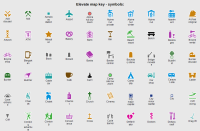
Downloads:
Current version:
5.4, 04/04/24 (changelog)
last update of the map key: 04/04/24
Notifications about new versions: subscribe this thread in the forum.
Donations: The Elevate map style family is available exclusively on openandromaps.org to support this project.
Therefore I ask you if you like my map styles to donate via the button to the right to cover the ongoing costs of Openandromaps!
Elevate 5
Recommended map style for OpenAndroMaps, compatible with apps that support mapsforge 0.19.0 or higher. If Elevate 5 doesn't work please try an Elevate legacy version.
| Quick install in Android (recommended) |
| Default maps app* * Default maps app: apps that support quick install in Android OruxMaps Locus (zipped) Locus (unzipped) Locus (zipped): for Locus Pro 3.56.4+ or Locus 4.5.6+, earlier versions should use Locus (unzipped). BackCountry Navigator BikeComputer |
Manual download (advanced) Download Elevate.zip Download Elevate_Locus.zip Locus: Download incl. map key + symbols for map theme switcher |
Elevate legacy versions
Elevate 5.2
Last version with mapsforge 0.6.1 compatibility, which isn't maintained anymore.
Last update: 06.11.22
| Quick install in Android (recommended) |
| Standard Karten App* * Default maps app: apps that support quick install in Android. OruxMaps Locus (zipped) Locus (unzipped) Locus (zipped): for Locus Pro 3.56.4+ or Locus 4.5.6+, earlier versions should use Locus (unzipped). BackCountry Navigator BikeComputer |
| Manual download (advanced) |
| Download Elevate52.zip Download Elevate52_Locus.zip Locus: Download incl. map key + symbols for map theme switcher |
Elevate LE
Legacy version only for Locus while using V3 maps, which isn't maintained anymore and is only available, as Locus uses a different software for rendering V3 maps which doesn't support current map styles.
Final version: 4.3.3.2, 25/11/19
| Quick install in Android (recommended) | Manual download (advanced) |
| Quick install | Download |
Elevate 2
Legacy version, that is no langer maintained and is only available to keep compatibility with all apps that only support mapsforge up to 0.3/0.4. New features of the maps will not be added, and there might be problems with future map versions.
Final version: 2.8.6, 08/10/18
| Map style size Pixel density of the display | Download |
| Elevate 2 approx. 240dpi | Normal version (Mapsforge 0.3) OruxMaps 6.0 (Mapsforge 0.4+) Locus only |
| Elevate 2 L approx. 320dpi | Normal version (Mapsforge 0.3) OruxMaps 6.0 (Mapsforge 0.4+) Locus only |
| Elevate 2 XL approx. 480dpi | Normal version (Mapsforge 0.3) OruxMaps 6.0 (Mapsforge 0.4+) Locus only |
How to install & use for Elevate 2
Differences in the map key for Elevate 2:
Variants: As there aren't map styles in Elevate 2, there are theme variants called Elevate_Hiking, Elegant_City and Elevelo_Cycling. All things that are possible with mapsforge 0.3 are still valid as is described for the map styles below. Overlays with switchable symbols or strongly emphasized hiking/cycling routes and public transport network, and also hiking waymarks, are not possible. Also very complex additions are not adapted.
Elements_Backcountry: All elements of Elevate and Elevelo (except mountain bike difficulty levels) are shown, hiking and cycling routes as well as the highly emphasized footways and paths in one map, as well as showing everything as soon as possible. Therefore the colored dots at low zoom levels aren't necessary. If cycling and hiking route are on one way the cycling route is rendered dashed above the hiking route so both are visible.
Routes: Routes use different colors and look different.
Hiking: International and national hiking routes are magenta. Regional hiking routes are green. Local and other hiking routes are yellow.
Cycling: International and national cycling routes are violet. Regional cycling routes are red. Local cycling routes are turquoise. Mountain bike routes are greenish yellow.
Variants:
There are two different variants of the map styles contained in the downloads respectively:
Elevate
I developed Elevate for mountain hiking in the alps. At first it was based on the standard hike and cycle map style of Openandromaps, but has been completely revised since. I added additional variants by and by for other uses, by user requests.
Everything should be self-explanatory without a key, as far as it's possible with the possibilities of mapsforge. Therefore I based it on the presentation on paper maps and guideposts in German and Austrian areas. Unified symbols and colors are used. At higher zoom levels names of amenities and areas are shown. As many things which are relevant for hiking and travelling as possible are shown without coming too much to the front or eliminating one another - e.g. big symbols or captions - therefore some symbols and captions are shown at high zoom levels only.
With Elevate 3 overlays were introduced which make it possible to switch certain elements on or off. Those can be chosen, as well as the map styles, directly within the app.
Elevate has been tested and developed with current versions of Cruiser and OruxMaps.
Elements
Elements is a modification of Elevate and is made for sparsely populated/mapped areas or countries, mostly backcountry usage, e.g. the outback of Australia, Iceland outside of the cities etc.
Elements contains the same map styles and details as Elevate. Only all content is shown as soon as it is contained in the map. Therefore the colored dots at low zoom levels aren't necessary.
In densely mapped areas this variation is not recommended, in those it is slow and unclear.
With Elevate 5 Elements can help to find specific things in the map - just activate only the overlay which you want to view and not the others (e.g. "Amenities" if you are looking for drinking water) and then all appropriate symbols are shown as soon as possible.
Map styles & options:
Elevate and Elements contain several map styles and options which can be chosen within the app (how this works depends on the app). The map style differ from each other in their purpose and in what can be displayed. Every map style has a different default selection of options which are selected, and for every map style different options are possible.
Essential to the rendering of the map style is how footpaths/cycleways/MTB trails are displayed - always optimized for chosen the activity, e.g. hiking/MTB difficulty is shown in the respective map styles.
Hiking
Key aspect is to have good overview for all features which are relevant for mountain hiking and perceptibility of paths and track, especially their difficulty and character (or if there isn't any information about that). Cycleways which are allowed for pedestrians look similar to footways. As "Hiking" is the basis for the other map style characteristics like the display of landscape features are included in those.
City
This is a light version which is especially useful in cities, for example for sightseeing or for everyday life.
Neither hiking nor cycling routes are shown. The highly emphasized footways and paths of "Hiking" are discreet and difficulty and visibility is not marked. Cycleways which are allowed for pedestrians look similar to footways.
Additionally for better overview at lower zoom landscape and protected area names and colored dots are missing. Therefore this variation is most suitable for finding names of settlements.
A public transport network can be overlayed.
Cycling
As this is a cycling version instead of hiking routes cycling routes are shown strongly. The highly emphasized footways and paths of "Hiking" are slimmer and difficulty and visibility isn't marked. Cycleways are strongly emphasized and surface information is shown if it's in the map data. Ways where cycling isn't allowed are marked with a turquoise cross hatch.
Mountainbike
Based on "Cycling" this map syle shows MTB difficulty levels on tracks and paths, visibility of paths and MTB routes.
Options
With options different things can be switched on and off. Since Elevate 4.5 certain letters are put in front as categories: [A] for areas; [P] for POIs (points of interest); [R] for routes;[W] for ways.
Map key:
Captions
- Black are peaks.
- Red are alpine huts.
- Grey, dark green and brown are landscape names.
- Green with white outlines are protected areas.
Other colors of captions are those of the assigned symbols.
Symbols
I hope that the symbols are mostly self-explanatory. Additionally, you can find an overview image of all symbols including their names by opening the image linked below. This image is also included in the PDF map key available above.
Most symbols are appearing at zoom 14 or higher, some important points of interest are marked earlier by colored dots:
(Hiking/Cycling)
![]() Alpine hut
Alpine hut
![]() Camp site
Camp site
![]() Hospital
Hospital
Public transport stations
Public transport stations are marked by colorered dots:
![]() Bus stop (large: bus station)
Bus stop (large: bus station)
![]() Tram
Tram
![]() Subway
Subway
![]() Railway
Railway
![]() Ferry
Ferry
Paths and Footways
 | Brown - unpaved path/footway (or path without surface information) without difficulty information |
 | Grey - paved path/footway (or footway without surface information) without difficulty information, on the top one cycling is also allowed (only in hiking mapstyle) |
Hiking paths
(Hiking)Path difficulty uses the SAC hiking scale, however the colors here are according to those used in the eastern alps.
Additionally trail visibility (if it's available in the data) is marked by how the paths are dashed.
 | Yellow - Hiking: flat or slighty sloped, no fall hazard, SAC T1; in the example without information about trail visibility (if this information is missing is only shown on paths with difficulty information): long dash, short dash, short spaces |
 | Blue - Mountain hiking: partially steep, fall hazard possible, SAC T2; in the example trail visibility is excellent or good: very long dash, short spaces |
 | Red - Demanding mountain hiking: not always visible, may be secured, hands may be needed, partly exposed with fall hazard, SAC T3; in the example trail visibility is intermediate: medium length dashes and spaces |
   | Black - (Difficult/demanding) Alpine hiking/Via Ferrata: no trail, very exposed, climbing, glaciers etc., SAC T4-T6; only with adequate experience, inform yourself about it before you go; in the example trail visibility is bad, horrible or no visibility: short dashes, long spaces additionally T5 paths dashes are broken vertically, T6 vertically and horizontal |
Safety measures
On some paths fixed safety measures are included in the maps:
 | A cable, chain or rope to hold on to; here the grey dots on the path mark the length of the area with safety ropes |
 | Rungs, stemples, pins |
 | A ladder |
Via ferratas
Via ferratas are marked with thick grey bars and a green via ferrata symbol. Depending on how the data is mapped they can have two different styles:
 | Mapped as via ferrata |
 | Mapped as a path (including hiking difficulty) |
Hiking routes
(Hiking)Hiking routes are rendered below paths and tracks starting at zoom level 14, till level 13 transparent above them.
International hiking routes are blue.
National hiking routes are red.
Regional hiking routes are green.
Local and other hiking routes are yellow.
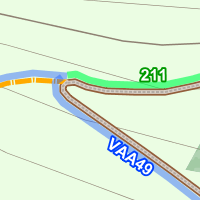 | In this example an international hiking route in blue called VAA49 and a regional hiking route in green with the number 211 can be seen. |
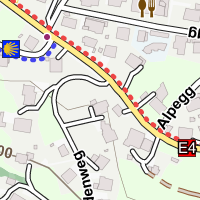 | Waymarks can be overlayed as an option, like the Jacobs mussel or the "E4" here; in lower zoom levels only a small symbol with the background color is shown. If a waycolor is given, it is marked along the trail with colored dots. |
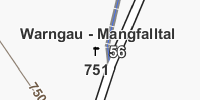 | If waymarks is actived, guideposts are shown a bit earlier, and, if available, their reference number is shown right of the symbol in white with brown border. |
Cycling routes
(Cycling/Mountainbike)Cycling routes are rendered below streets starting at zoom level 14, till level 13 transparent above them.
International cycling routes are blue
National cycling routes are red
Regional cycling routes are violet
Local cycling routes are turquoise
(Inter-)national and regional mountain bike routes are green
Local and other mountain bike routes are yellow
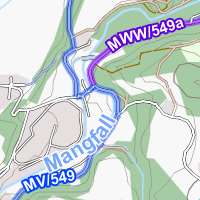 | In this example an international cycling route in blue that goes from south-west to north, besides a regional route in violet. |
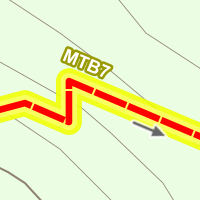 | A local MTB route in yellow which also shows with an arrow the proposed route direction. |
Mountain bike difficulty levels
(Mountainbike)Mountain bike difficulty levels are shown according to the MTB Scale, you can find all details there.
Additionally trail visibility (if it's available in the data) is marked by how the paths are dashed.
 | S0: Blue bars on ways: no special driving skills required. In this example you can see how it is shown on tracks. |
 | S1: Blue-red bars on ways: basic driving skills required, obstacles can be passed over; in the example without information about trail visibility |
 | S2: Red bars on ways: advanced driving skills required; in the example trail visibility is excellent |
 | S3: Red-black bars on ways: very good bike control required; in the example trail visibility is good or intermediate |
 | S4: Black bars on ways: at least perfect bike control with trial skills required; in the example trail visibility is bad, horrible or no visibility |
 | S5/S6: Several thin black bars on ways: exzellent mastering of special trail techniques required or nearly completely impassable; in the example without information about trail visibility |
 | Easy hiking path: Yellow bars alternate with brown bars: if MTB scale isn't available it is possible to mark easy hiking paths (according to SAC T1, see above) with an overlay. If and how those are rideable isn't for sure, and if it is allowed to ride them depends on local legislation. |
MTB Scale uphill is marked by horizontal dashes under ways:
 | 0: Blue dashes: 15% incline max. |
 | 1: Blue-red dashes: 20% incline max, the two bars with different length also mark the uphill direction - the shorter one points uphill. |
 | 2: Red dashes: 25% incline max. |
 | 3: Red-black dashes: 30% incline max |
 | 4: Black dashes: 40% incline max |
 | 5: Two thin black dashes: uphill riding not possible. |
Tracks
Forest tracks and agricultural roads are marked in Openstreetmap by grade:
 | Paved track |
 | Unpaved track, gravel road |
 | Track made out of a mixture of gravel and dirt |
 | Track mainly made out of dirt/grass, some gravel |
 | Track only made out of dirt/grass |
 | Track without grade |
 | Bridleway |
Cycleways and road surfaces
If a normal road (not tracks/paths) or cycleway (when using cycling/mountainbike) has a different surface than asphalt or another flat sealed surface it is marked as following, if the "surface" is included:
 | Cycleways have a blue border. This only means that cycling is allowed here. If the border is a continous line, the way is paved, dashed means unpaved or unknown. The picture shows an emphasized cycleway in the cycling map style without surface information, which is marked by thin stripes along the way. |
 | Cycleway which might need a cross-country bicycle because of steepness/roughness (only in cycling mapstyle, not MTB) |
 | paved/asphalt |
 | paving stones or similar |
 | cobblestone or similar |
 | compacted unsealed road |
 | loose gravel |
 | natural ground |
 | Option "extended road surfaces": paved/asphalt (on major roads white alternating with color of road importance, on normal roads just white) |
 | Option "extended road surfaces": no road surface information available |
 | Option "emphasized paved cycle paths" (Cycling) |
 | Option "emphasized paved footways" (City) |
 | Bicycle road |
Access limits
Only those access limits are shown, which are valid for the mode of transportation the map style is intended for. In "Hiking" only if they are valid for pedestrians. In "Cycling"/"Mountainbike" only, if they are valid for cyclists. In "City" only general access limits.
 | Local traffic only - only when travelling to this area. |
 | Private road - only with permission of the owner. |
 | No access allowed. |
 | Option marking of permitted foot/cycle paths: usage permitted - important for countries like England, where e.g. a track can only legally be used if it's permitted for this track |
 | toll road, marked by red dots |
 | only use with permit (might be with costs), marked by green dots |
 | Pedestrian area or wide footways (possibly also cycling), if cycling is prohibited it's shown as above |
Winter sports
To avoid collisions or not so nice areas ski and sled pistes are marked unobstrusively:
 | Ski piste (with hiking path) |
 | Sled piste (on track) |
 | cross-country ski-tracks |
Landscape
| Fell/Mountain meadow | |
| Heath/dwarf-shrub | |
| Wetlands/Marsh | |
| Rock | |
| Scree, loose rocks | |
| Scrub | |
| Wood, forest mixed | |
| Wood, forest coniferous | |
| Wood, forest deciduous | |
| Glacier | |
| Meadow, grass | |
| Farmland | |
| Orchard | |
| Vineyard | |
| Plant Nursery | |
| Body of water | |
| Intermittent body of water (sometimes water, sometimes dry) | |
| Military |
 | Protected area |
 | Strictly protected area with strictly limited access |
 | Protected area, seasonal strictly limited access |
 | Protected area, discouraged access (might be seasonal) |
 | Protected area, no off-road access (might be seasonal) |
 | Aboriginal lands |
 | Cliff, rock face |
 | Ridge, arete |
 | Earth Bank |
 | Gully |
 | Ditch |
 | Dyke |
 | Cut/Hollow way |
 | Embankment |
 | Prominent Tree |
 | Spring |
  | Powerline/Minor powerline |
License:
Elevate, Elegant, Elements & Elevelo by Tobias Kühn
These map styles are licensed under a Creative Commons Attribution-NonCommercial-ShareAlike License. For commercial usage it is licensed under a Attribution-NoDerivatives License.
Please have a look at licenses.txt for reuse and licenses of resources used in this map style.
Contact: https://www.eartrumpet.net/contact/
